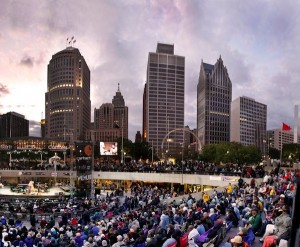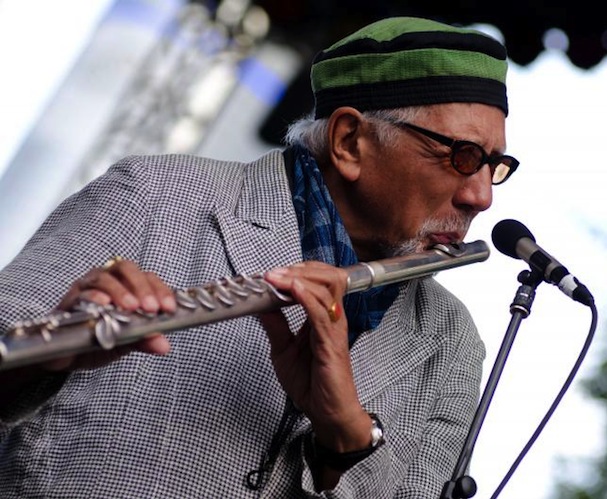Fuse Music Commentary: Free-For-Alls Bode Well for Jazz’s Future
The obvious question is how can such a sprawling free festival – and the nightly fireworks shop that capped two of the nights – happen in such a cash-strapped city?
By Noah Schaffer
There’s been a lot of recent handwringing about the audience for jazz. Studies and articles have bemoaned that it’s too small, too elite, too white and – especially – too old.
But the recent Detroit and Northampton Jazz Festivals proved what anyone who has been to Boston’s Berklee BeanTown Jazz Festival already knows: if the price is free and the location is right, there’s no reason that a serious jazz event can’t be enjoyed by large and diverse audiences.
Although it’s been going for 34 years, Detroit has recently reinvented itself as an event that presents vast quantities of pure jazz on a very large scale. Following a kickoff concert on Friday, there were four stages running until late in the evening plus an interview tent. Danilo Perez, David Murray, Cecile McLorin Salvant, Ellington historian David Berger, Lee Konitz and the rearranged works of Dave Brubeck were all featured with big bands. Endlessly creative vocalist Sheila Jordan and saxophonist Joshua Redman both had lush string sections behind them. An entire theatre company was assembled so that “The Real Ambassadors,” a swinging and politically charged musical written by Brubeck and his wife Iola, could be given its first performance since it debuted in 1961.
Much of the jazz at the Detroit fest was of the mainstream variety, but that doesn’t mean it wasn’t eclectic: it’s got to be the only event where a tribute to the late Detroit hip-hop genius J Dilla (via the Robert Glasper Experiment) could come right after the presentation of a full Mass (one composed by Brubeck and performed by his sons with a full choir and yet another string section).
What Detroit didn’t have this year were R&B crossover headliners like Take 6 and Tower of Power who graced its stages just three years ago. Their drawing power wasn’t missed – if you didn’t arrive early for Ahmad Jamal or McCoy Tyner’s collaboration with tap dancer Savion Glover you couldn’t get anywhere near the stage. Given all the times I’ve seen brilliant artists play to shamefully small houses, it was thrilling to see thousands leap to their feat in appreciation of Jamal’s playful antics or the way Glover used his feet to trade improvisations with drummer Francisco Mela.
It was probably unintentional, but two of the acts most associated with jazz’s avant-garde wing were presented in crossover contexts. David Murray brought along Macy Gray, and while she’s no master improviser, her appearance injected the proceedings with plenty of sass and star power. Bill Frisell appeared as an ideal foil for contemplative saxophonist Charles Lloyd, and then returned the next day to perform a John Lennon tribute with an incendiary band that included violinist Jenny Scheinman and pedal steel guitarist Greg Leisz. While the audience roared for familiar riffs like “Come Together,” their standing ovation at the end was for the stellar performance, not the nostalgia.
It was great seeing octogenarian legends like Jamal, Jordan, Konitz and the classy Freddie Cole. But of course the music needs a future as well. A wide array of impressive student groups opened each days’ proceedings. Vibraphonist Warren Wolf, who’ll also be at the BeanTown Fest later this month, was a sure crowd pleaser wherever he turned up. Breakthrough vocalist Gregory Porter, who is about to release an album on Blue Note, connected big time by playing up the gospel roots of his original songs.
After a weekend of so many big bands it was refreshing to hear the sheer muscle of saxophonist JD Allen backed by just bass and drums. Allen also appeared at a panel on Detroit jazz where he spoke bluntly about what will happen when his bankrupt hometown cuts arts out of its schools. “When I was growing up, if you wanted a piece, you knew where to get one. I was able to take out a saxophonist instead,” he recalled.
Konitz deployed his trademark dry alto sound in daring rearrangements of standards with both his quartet and in an intimate “Talk Tent” where he did duets with pianist Dan Tepfer. That set’s Q&A portion had some of the weekend’s most bizarre moments. Konitz spoke dismissively about a “schmaltzy” long-deceased Detroit musician and then jumped off stage and ran outside the tent to tell a street percussionist to stop banging a bucket. When a few audience members left after a tune – an inevitable occurrence with four competing stages – Konitz counted the number of departures and then barked at one fleeing couple that “if you stay maybe we’ll talk about Buddy Guy.”
There was also a significant Boston presence. Artist-in-residence Danilo Perez played a large scale piece, did a set of duets with Detroit great Geri Allen, and unveiled a new project, Panama 500, that largely revolves around Berklee grad Alex Hargreaves, who usually tours with NEC alum Sarah Jarosz. Gary Burton appeared in an all-star configuration with his Mack Avenue Records label mates and read excerpts from his new autobiography Learning to Listen. Berklee’s Unlimited Perception played am impressive strain of world fusion.
The obvious question is how can such a sprawling free festival – and the nightly fireworks shop that capped two of the nights – happen in such a cash-strapped city? The answer is largely the largesse of Gretchen Valade, heiress to the Carhartt industrial clothes fortune, who has endowed the festival. (She also owns the Mack Avenue label.) Additional funds come from audience donations, a membership program and corporate sponsors. Valade’s approach of financing a well-curated free event with roots in its city’s cultural heritage could be instructive to other well-intentioned philanthropists, such as Boston’s Ted Cutler, whose Outside the Box festival had a mixed debut earlier this summer.
While the one-day Northampton fest happened on a much smaller scale, it packed a pretty impressive punch for an event that is only in its third year. Either/Orchestra alum Haley Niswanger bravely explored deep post-Coltrane territory with her quartet. 78-year old tenor great Houston Person delivered his impeccable soul-jazz sound backed quite ably by the local Green Street Trio. Bassist Ben Allison and his group showed what happens when masters improvisers embrace an indie-rock aesthetic. Veteran drummer Al Foster closed the night with his more traditional but highly effective quartet that featured saxophonist Eric Alexander and Boston native Adam Birmbaum on piano.
A beer tent was provided for those who wanted to socialize – which happily meant that the other audience areas were filled with respectful listeners. And there was ample room to accommodate both students who wanted to dance and older listeners who brought lawn chairs. That’s a good way to both please the current jazz audience while making sure that there will be one in the future.
Tagged: Berklee’s BeanTown Jazz Festival, Detroit Jazz Festival, Jazz Festival




I’ll take a free festival (almost anywhere, like Detroit) over the Bean-Town offering. Maybe we need to take a hint (we have rich enterprising residents) including the lineup? But then, “free” too often means compromising the bookings, limiting the lineup–and hardly any adventurous & free-form. Sorry, Bill Frisell alone doesn’t represent creativity. That means it’s artistic character will be dictated not by the love, knowledge and risks (which defines Jazz, eh?) of the music, but popularity and safety, how the investment world operates. How any club, college does for that matter. And in Detroit’s case, a typical schedule: “…See, you can live without services, jobs, pride ’cause we’re giving you a freebee, a coliseum event for the masses, be happy…, don’t dare look at the 1% who’s expensing this”. It has to be politicalized.
I’m sorry, I just can’t accept what is provided to us by TPTB, Detroit or here, and no one seem to realize that the result is a compliant, pedestrian, ignorant consituency-listenership-media that is behind the 8-Ball – and the musicians suffer most of all.